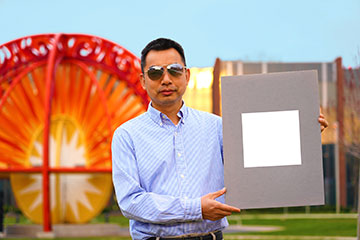
Xiulin Ruan holds up his lab’s sample of the whitest paint on record. [Image: Purdue University/Jared Pike]
A fresh coat of paint can do a lot to spruce up a building—but can it cool it down?
Researchers at Purdue University, USA, have engineered what they say is “the whitest paint yet,” which could one day keep surfaces cool enough to reduce the need for air conditioning (ACS Appl. Mater. Interfaces, doi: 10.1021/acsami.1c02368). This particular shade of white is made from particles of barium sulfate and reportedly reflects up to 98.1% of sunlight.
Passive cooling particles
Radiative cooling is a passive cooling process by which an object’s temperature lowers by emitting heat without absorbing energy. As this doesn’t require electricity, scientists are interested in employing radiative cooling to lower building temperatures as well as carbon dioxide emissions from air conditioning.
The idea of radiative-cooling paint, says Xiulin Ruan, professor of mechanical engineering at Purdue, has been around since the 1970s. However, in the past, radiative-cooling paints only reflected 80% to 90% of sunlight and absorbed the remainder—which is too much heat to provide daytime cooling. Although multilayer solutions like nanostructured films and photonic structures can achieve full-daytime cooling, Ruan points out, his team is attracted to the simplicity and scalability of single-layer paints.
The first challenge, says Ruan, was to identify the appropriate paint material. The researchers tried multiple high-electron-band-gap materials in an effort to sidestep solar absorption, eventually realizing that a combination of broad particle size distribution and a high particle concentration were key.
“By spreading out the particle size,” explains Ruan, “the paint can effectively reflect a broad range of sunlight, leading to high performance overall.” Furthermore, he says, the wide range of sizes actually reduces costs by easing up on particle synthesis requirements.
Mind the band gap
With these two things in mind, the researchers then tried different materials and ratios. Last year, they demonstrated a calcium-carbonate-based paint which achieved 95.5% reflection. The current work improves on that percentage by using barium sulfate (BaSO4) particles—a large-electron-band-gap material that doesn’t absorb ultraviolet or visible light, and has high sky window emissivity.
In tests, the BaSO4-acrylic paint reflected 98.1% of sunlight, absorbing just 1.9% as heat. This, Ruan explains, is double the cooling power of the calcium carbonate paint. Typical TiO2-acrylic paint, on the other hand, has high absorption in both the ultraviolet and infrared band, so it always heats up under peak sunlight.
What’s more, explains Ruan, barium sulfate is low cost, environmentally safe and widely available—approximately half the price of TiO2 powders.
Cooling in color
After mixing up the paint, it was time to test its cooling ability. Using a spectrometer, the team characterized the paint’s reflectance to see how well it could avoid overheating, as well as its infrared emission to know how much it cooled itself down via thermal emission.
To characterize how the paint might perform under realistic conditions, Ruan and his colleagues measured the temperature of the paint and the outdoor environment. They found that the paint sample was cooler than the ambient, showing that the paint could cool itself down even under direct sunlight. Another setup employed a heater to heat the sample to the ambient temperature, thereby characterizing the cooling power of the paint in the form of the heater’s power consumption.
Next, the Purdue team plans to optimize and commercialize its radiative cooling paint. Some target applications include building envelopes, cars and outdoor equipment. Another possibility, says Ruan, is colored radiative cooling paints. Although not as effective as ultra-white paint, colored paints would still save on energy compared with traditional paints without sacrificing aesthetics.
